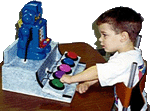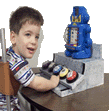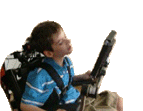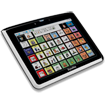|
PC-0607
|
Shopping Basket Program
Shopping Basket gives
participants an effective and enjoyable way to practice "real-life"
math skills in the form of a grocery shopping trip.
Participants keep track of the dollar amount they are spending when
shopping at a grocery store as they learn the importance of staying
within a budget. This program teaches participants the importance of
not choosing more food items than their grocery budget allows. This
important life skill will help them to avoid the embarrassment of
having to put items back at the checkout counter. This money math
program focuses on skills such as staying in a budget, performing
simple addition and subtraction, paying with cash or a personal
check, and using a calculator.
Participants pretend they are in a grocery store while the game is
being played. They select food items to buy from a deck of 96 food
Draw Cards and put the foods on their "Shopping Basket" playing
mats. The game is divided into eight categories with 12 food
products each. The eight categories are Dairy, Produce, Meat & Fish,
Breads, Frozen Foods, Canned Foods, Condiments, and Snacks. The
full-color illustrations and large type on the Draw Cards offer an
excellent way for players to learn to identify and pronounce the
common food items.
Components
Game includes four Shopping Basket Playing Mats, with easy-to-clean
laminated surfaces, and color-coded to match the 96 Draw Cards,
divided into the eight categories described above; one Draw/Discard
Game Mat, with easy-to-clean laminated surface; one Big Digit
Calculator, with large finger pads for ease of use and a large,
easy-to-read digital screen; one Addition Shopper Score Sheet Pad,
One Subtraction Shopper Score Sheet Pad; one reproducible Budget
Slips Blackline Master; four "Wallet" Envelopes to hold budget
slips, money, and blank checks; two Check Pads with realistic
checks; realistic bills and coins in an assortment of denominations;
one die, four pencils, and Teacher's Guide.
Play in two ways:
Pay for Groceries
This version of the teaching game uses Addition Shopper score sheets
with all players beginning with the same dollar amount budget.
Participants are given a "wallet" envelope with either cash or a
blank check so they can pay for food purchases at the end of the
game. The shoppers are asked to fill all six spaces on their playing
mats by purchasing six food items from six different food
categories. They use the Big Digit calculator to keep a running
total of the money spent. When all six categories on the shopping
basket playing mat are filled, players check to see if they have
stayed in budget. Players then pay the Game Monitor (who can be a
teacher, paraprofessional, or peer buddy) for the grocery purchases
with cash or a personal check.
Watch Your Budget
This version of the teaching game uses Subtraction Shopper score
sheets with all players beginning with the same dollar amount
budget. The shoppers are asked to fill all six spaces on their
playing mats by purchasing six food items from six different food
categories. They write the beginning budget amount on the top of the
Subtraction Shopper score sheet. As each food item is purchased,
they use the Big Digit calculators to keep an eye on the remaining
balance of money. If a participant fills all six categories on his
or her mat without running out of money, he or she has stayed in
budget.
Special Features
There are optional ways to play these two teaching games noted
throughout the Teacher's Guide. Participants who have progressed to
a better understanding of checking the prices of foods before buying
them will be ready for more challenging formats. After the students
have played the game for awhile, it will be apparent to many players
that some of the food items have higher prices than others. Allowing
players to choose whether to purchase lower or higher priced food
items will help them to better understand the type of money
management decision that have to be made when shopping at a grocery
store. Please note that there are pieces in the game not suitable
for children under three or any individuals who have a tendency to
place inedible objects in their mouths. The small parts may present
a choking hazard.
Product Type: Game
Teacher's Guide: Yes
Number of Players: 1-4 players
Reproducible: No
Reading Level: High-interest/Low-level reading
f
Age Appropriate Level: Elementary, Secondary, Adult
Copyright: 1997
|
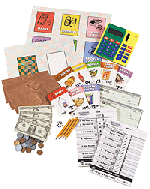
|
|

